Double Deck Blackjack
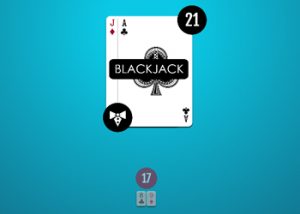 As we have discussed before, the number of decks with which a Blackjack game is played is essentially a rule unto itself and impacts the House Edge of the game accordingly. In the event that all other rules are equal, then the more decks a Blackjack game has, the greater the House Edge will be against the player, which is to say that there will be a lesser return to player.
As we have discussed before, the number of decks with which a Blackjack game is played is essentially a rule unto itself and impacts the House Edge of the game accordingly. In the event that all other rules are equal, then the more decks a Blackjack game has, the greater the House Edge will be against the player, which is to say that there will be a lesser return to player.
In the case of card counting, multiple decks are something of a boon and a bane to card counters. Granted, all other things equal, the card counter will generally get more favorable opportunities against a lesser number of decks and will buck a lesser negative expected value while waiting for positive counts, (because fewer decks is generally good) but all other things are not equal and games considered, ‘Highly countable,’ are often subject to greater scrutiny from the pit as well as the eye in the sky. Even though it is dead wrong, there are still pit bosses out there who believe, ‘A six (or eight) deck game cannot be counted.’
Double deck games, either way, certainly can be counted. However, for the basic strategy player, double deck games offer fewer opportunities than single-deck games to make decisions based on the, ‘Deck composition,’ and it is for that reason that double deck has a greater house edge.
When we compare the rules of double-deck variations, we are going to use what I will term a, ‘Control Game,’ and that control game will have the following rules:
Soft 17: Dealer Hits
Double After Split: Yes
Double On: ANY
Player Can Resplit: Twice to Four Total Hands
Resplit Aces: No
Hit Split Aces: No
Dealer Peeks: Yes
Surrender: Yes
Blackjack Pays: 3:2
With this, ‘Control Game,’ the House Edge with Basic Strategy is 0.39702%, if we compare that to single-deck with the exact same set of rules, the single deck game would have a House Edge of 0.12144% for a difference of 0.26928% added to the House Edge for the double-deck game.
This is not only because of fundamental hands/decisions being more powerful for a player in a single-deck game due to the effect-of-removal (cards coming out of the deck) but also because there are some plays that get made as a result of effect-of-removal in a single deck game that do not happen in a double-deck game, such as doubling an eight against a dealer showing five/six in a single-deck game. You would not do that in a double deck game.
The Rules:
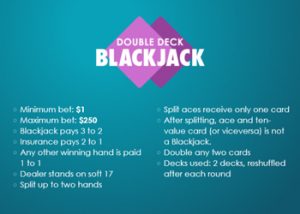 While double-deck Blackjack gives the player an opportunity to play deck composition strategy, it does not grant the same opportunities that a game such as single-deck often will. Deck composition strategy is basically what card-counters do, except they can often do this with games of several decks and are doing more than making decisions based only upon the number of cards that have come out/are showing in one hand. While such decisions still come up in double-deck Blackjack for the savvy player, they are nowhere near as common as they are in a game of single-deck.
While double-deck Blackjack gives the player an opportunity to play deck composition strategy, it does not grant the same opportunities that a game such as single-deck often will. Deck composition strategy is basically what card-counters do, except they can often do this with games of several decks and are doing more than making decisions based only upon the number of cards that have come out/are showing in one hand. While such decisions still come up in double-deck Blackjack for the savvy player, they are nowhere near as common as they are in a game of single-deck.
Soft 17
The first rule change we will examine is whether or not a dealer hits or stands on soft-17, which is any hand that adds up to seventeen with the Ace counting as eleven. In other words, A-6 would be an example of a Soft-17, A-2-4 is another example and A-2-2-2 is yet another. These types of hands actually come up slightly more frequently in a double-deck game as opposed to a single-deck game (and even more frequently in games of greater decks) simply because the effect of a card, say a deuce, being removed on the probability of getting yet another deuce is greater with a fewer number of decks.
The rules for our control game assume that the Dealer Hits on a total of soft-17 whereas it would be beneficial for the player for the dealer to stand. While it may seem antithetical that a player benefits by the dealer standing on what then becomes a completed hand, it is important to remember that the player has already acted and that hitting a Soft-17 gives the dealer several opportunities to improve the hand with a nearly equal number of opportunities to keep it the same as if the dealer had stood. (i.e. turning it into a Hard-17 with a ten)
For example, if two cards, an A-6 come out of the deck giving the dealer a Soft-17 and the dealer hits, here are the possibilities for the very next card:
(31/102)-The dealer improves his hand to a 18-21 by way of another Ace, or a two, three or four. The four, of course, would give the dealer an unbeatable twenty-one that can only be matched for a push if it matches the player’s total.
(32/102)-The dealer draws a ten-card that results in a Hard-17, which is what the dealer would effectively have even if he stood on soft-17.
(39/102)-The dealer draws a five, six, seven, eight or nine, which are arguably the worst cards for the dealer because the hand is incomplete and busting is now possible. Even with that being the case, though, assuming the player plays perfect strategy based on the rules, the player will have a hand that beats (or pushes) seventeen enough of the time that the dealer is better running this risk.
One might wonder: But, aren’t 39, ‘Bad cards,’ more than 31, ‘Good cards,’ what gives?
The answer to that is simply that the, ‘Good cards,’ absolutely make a hand that is better than what the dealer had if forced to stand on the Soft-17, and the, ‘Bad Cards,’ are not necessarily a death sentence for the dealer. The dealer could draw a five to a Soft-17, for example, giving the dealer a hand total of 12, then the dealer could draw a nine for a total of 21, which can only be pushed by the player.
There’s no need to believe me, though, you could simply look at our blackjack strategy engine:
And you will see that, with Basic Strategy, based on our control game, when we switch it to force the dealer to stand on Soft-17, the house edge is reduced to 0.20416%, which is a difference of 0.18656% in favor of the player. In other words, this one rule change cut the house edge nearly in half as compared to our control game!
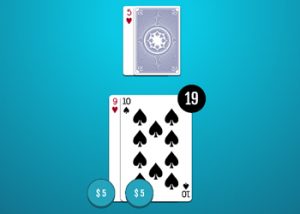 Double On Any Two Cards
Double On Any Two Cards
The next rule that we must take a look at is the doubling rule, some casinos will allow a player to double on any two cards the player likes, whereas other casinos only allow doubling on hand totals of 9-11 and others still only allow doubling on hand totals of 10-11. While a single deck game is the only time a player would double on hard eight (absent card counting) there are still a number of soft hands that do not otherwise total 9-11 on which a player would double in the double deck game.
For example, a player would double a soft 13-19 against a dealer six, and only the A-8 technically equals nine (in terms of the hard hand), the player would double soft 13-18 against a dealer five, a soft 14-18 against a dealer four, a soft 17-18 against a dealer three and a soft 18 against a dealer deuce. With exception to the soft nineteen (which, again, would also be a hard nine) against a dealer six, all of these plays would be gone if the player could not double on anything.
Our control game allows for doubling on Any Two cards, however, if we switch that to doubling only on 9-11 and keep all other rules the same, (eliminating all soft doubles except one) the house edge soars to 0.51298%, which is a difference of 0.12226% compared to being able to double on anything.
In addition to eliminating all soft double situations, the situation of doubling a hard nine against a dealer showing a 2-6 would also be eliminated if the player could only double on 10-11. If that were to happen, the House Edge would jump to 0.62725% which is 0.23653% more than in our control game in which the player can double on anything.
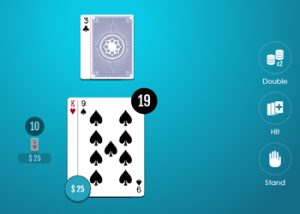 Splitting
Splitting
Now that we have discussed doubling, we have to look at splitting as well as the two together: Whether or not a player may double after a split.
The first question is to how many hands may a player split? For example, if the player is dealt a 8-8 (Hard 16) against any dealer card, (except an Ace, then the player should surrender if allowed) then the player is supposed to split the eights and take a new card on each of the two eights in order to form two new hands. In some Blackjack games, the player has the opportunity to do this yet again if the player were to draw another four on one of the other hands, and then perhaps even again after that! This process is called, ‘Re-Splitting,’ and the ability to do so is a favorable rule for the player. There are a few Blackjack games that allow unlimited re-splits, but it is extremely rare to ever resplit more than twice.
Our control game assumes a player can resplit (twice) to a total of four hands and the difference in being able to split to a total of three hand only (i.e. resplit once) rather than all four is 0.00570% added to the house edge whereas the difference in not being able resplit at all compared to resplitting to four total hands is 0.04456% added to the house edge. This may not seem like a big loss, but in the course of a lifetime of blackjack play, it adds up!
Like we discussed more exhaustively in the single-deck article, this is one rule that has a greater impact on the house edge the more decks there are. The reason for that is because of effect-of-removal, for example, in a hypothetical million deck shoe, getting 4-4, splitting, and drawing another four would not meaningfully reduce the probability of drawing another four on the next card still!
Double After Splitting
The next question relevant to the player is whether or not the player is permitted to double-after-splitting, and there is quite a variety of situations in which this becomes relevant! One example of a hand in which a player would want to be able to do so is a hand such as 3-3 against a Dealer five which is split and the player draws either a six, seven or eight, (depending on what the rules are for what a player can double on) that is definitely a situation in which the player would want to double after splitting.
If the player does not have the capacity to double after splitting, then the House Edge is increased by about 0.14534% to 0.53606% as compared to our control game. This difference becomes slightly greater if the player could split to multiple hands because more hands means more potential opportunities to double after splitting. Just like in our example hand, one of the advantages behind splitting is giving the player the potential not just to get out of a bad hand, but to also turn a bad hand into a GREAT hand that should be doubled down upon!
Blackjack rules typically dictate that a player can only Split Aces once, and the rules that we are assuming for the control game do not allow re-splitting of Aces. Resplitting Aces is advantageous for the player because, once split, aces can often not be hit upon or resplit, which means if you split two aces and draw an A to one of the split Aces, then you are stuck with a lousy hand total of hard-12. If the dealer makes a hand, you lose.
If our control game did allow for the resplitting of Aces, then the house edge would be reduced to 0.33758% which is a difference of 0.05314% off of the house edge of our control game.
Hit On Aces That Have Been Split
The next rule we will address is whether or not a player can hit on Aces that have been split. For the purposes of this rule, we are going to go back to assuming that the player may not resplit the aces because the player may not do so in our control game. The ability to hit Aces that have been split is an incredibly positive allowance for the player because it enables the player to take advantage of splitting Aces without worrying about any chance of being stuck on a bad (12-16) hand that cannot win unless the dealer busts. Sometimes the player would want to hit such a hand total if the dealer is not showing a bad card, but against something like a dealer six, of course, the player would still stand the bad hand total even if the player could hit.
Essentially, what happens if the player is allowed to hit split Aces is that the player will not be stuck on hand totals of 12-16 after taking the card on each of the split Ace hands. In fact, the worst case scenario, if the player cannot resplit Aces, is that the player ends up drawing another Ace (Hard 12 total) as that is the only, ‘Hard,’ hand the player can end up with, and therefore, the only hand in which a third card (the hit) could potentially bust the player. Otherwise, every card on the split aces will either give the player a completed hand, or alternatively, the potential to take a hit to improve the hand with literally zero risk of busting.
Given all of our other rules, the ability to hit Split Aces (no resplitting) improves the game to a house edge of 0.22421% which is an improvement of 0.16651% off the house edge compared to our control game.
No Hole Card
Another rule is the European, ‘No Hole Card,’ rule, and this is actually a rule that exists entirely on the dealer’s side, but it does impact a player’s decisions. If there is no checking of the hole card, then a player is forced to make decisions against a dealer Ten/Ace before knowing whether or not the dealer, ‘Has the goods,’ (a natural) and splitting/doubling decisions are affected by the fact that a player will lose the split/double amounts if the dealer has a natural. Rarely, there will be a casino that will play without the dealer checking for Blackjack, but the casino will only take the original wager if the player loses, and that is nearly effectively the same as the dealer checking for it.
There are a number of plays this influences in different ways, (in terms of the player needing to play more conservatively) but the biggest of these rules is that a player would no longer double a total of eleven against a dealer showing a Ten or Ace because the player has no way of knowing whether or not the dealer has a natural. With the hole card, ‘Peek,’ game, the dealer, ‘Peeks,’ and tells the player he/she does not have a natural hiding under there. Furthermore, the player will surrender against the dealer much more frequently (including with some soft hands under a ten total) if the dealer does not first check for Blackjack!
Is the ability to surrender more often good for the player? I’ll let you decide, the House Edge goes up to 0.49832%, which is an increase of 0.10760% if the dealer does not check for Blackjack compared to our control game.
Surrender
The next question is whether or not a player is allowed to Surrender, which means to forfeit his/her hand and receive half of his/her wager back if he/she does not like the hand. In a double-deck game in which the dealer checks for Blackjack, if allowed, the player would surrender any total of 15-17 (including 8-8) against a Dealer Ace, and a total of 15-16 against a dealer ten. The difference in House Edge is 0.06616% if the player is allowed to Surrender given all of the other Rules with looked at with the house edge of our control game increasing to 0.45688% if the player may not surrender.
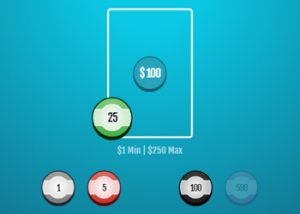 Blackjack Pays ?
Blackjack Pays ?
The final rule that we will look at is Blackjack paying 6:5 rather than 3:2. If the only game in town pays 6:5 on a natural: Play Craps.
How Do the Rules Affect Me?
When it comes to the effects of the Rules, let’s look at the most player-favorable set of rules for a double-deck game v. the most player unfavorable set of rules. I believe this will help everyone see how much of a difference the rules can make.
Favorable:
Dealer Stands on Soft 17
Double After Split: Yes
Double on: Anything
Resplit: Up to Four Hands
Resplit Aces: Yes
Hit Split Aces: Yes
Dealer Peeks: Yes
Surrender: Yes
Blackjack Pays: 3:2
With just Basic Strategy (as opposed to Optimal deck-composition strategy) the player advantage on this set of rules would be 0.00943%, which means that the player would have a very slight advantage with perfect Basic Strategy. Let us compare that with the worst possible set of rules:
Unfavorable:
Dealer Hits Soft 17
Double After Split: No
Double: 10-11 Only
Resplit: No
Resplit Aces: N/A
Hit Split Aces: No
Dealer Peeks: No
Surrender: No
With all of that, the house edge with Basic Strategy would be 0.95307%, which would mean the player is expected to lose about 95 cents of every $100 bet. The overall difference between these two games is 0.96250%, nearly a full dollar per $100 bet difference. If we make Blackjack pay 6:5 on our bad rules, the House Edge goes up to 2.32657%, and even with our otherwise great rules, the player advantage turns into a house edge of 1.36407%.
Like I said, 6:5 Blackjack sucks. Even changing every other possible rule to a good rule still leaves 6:5 Blackjack unplayable.
Conclusion:
The number of decks used in a Blackjack game, to a greater or lesser degree, enables the player to play using, ‘Deck composition strategy,’ which simply means making decisions based on the remaining cards in the deck which helps a player understand the probability behind what a dealer could have or is likely to have. Double Deck Blackjack, unfortunately, is not quite as fun as Single Deck Blackjack simply because there are fewer opportunities to play certain hands different ways as a single card does not affect the deck composition as meaningfully on a double deck game.
While, ‘The fewer decks the better,’ is a rule that is generally true with respect to Blackjack, it can also be a, ‘Sucker Rule,’ to a certain extent. In other words, while fewer decks are generally favorable to the player, the remaining rules can be adjusted in ways that render an overall Blackjack game less favorable regardless of the number of decks used. For that reason, it is important to look at a culmination of the number of decks used and the other rules, determining the house edge accordingly, before selecting a game to play.
Software Providers that have Double Deck Blackjack
| Software | BJ Pays | Soft 17 | Double | Re-Split Aces | Surrender | House Edge | Total Decks |
|---|---|---|---|---|---|---|---|
| Bodog | 3:2 | Stand | Any 2 | No | No | 0.20% | 2 |
Other Online Blackjack Variations
- 21 Burn
- Blackjack
- Blackjack Atlantic City
- Blackjack Atlantic City Gold
- Blackjack Multi-Hand
- Blackjack Switch
- Double Attack Blackjack
- Double Deck Blackjack
- Dr Fortuno Blackjack
- European Blackjack
- European Blackjack Redeal
- Lucky Blackjack
- Match Play 21
- Mutli-hand Blackjack
- Perfect Pairs Blackjack
- Pirate 21
- Pontoon
- Power Blackjack
- Single Deck Blackjack
- Sonya Blackjack
- Spanish 21
- Suit ‘Em Up Blackjack
- Super 21
- Zappit Blackjack